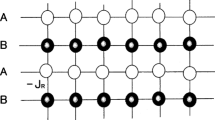Abstract
Magnetocaloric effects (MCEs) in two-sublattice anisotropic antiferromagnets with single-ion anisotropy of easy-axis type have been investigated upon orientation of a magnetic field both along and transversely to the easy axis of magnetization. It has been shown that MCEs that arise in a longitudinal magnetic field in the paramagnetic range above the Néel temperature T N are of a normal character, whereas in low fields in the magnetically ordered range below T N, they are anomalous: isothermal magnetization increases magnetic anisotropy and adiabatic magnetization reduces the temperature of the antiferromagnet. Upon the magnetization of anisotropic antiferromagnets perpendicular to the easy axis of magnetization above the Néel point T N, we observe normal (direct) MCEs that are weaker than in longitudinal fields and decrease with the relative growth of the single-ion anisotropy parameter D > 0. In low fields, upon magnetization by transverse fields below T N, as in the case of longitudinal magnetization, anomalous (inverse) MCEs arise, but they are several orders of magnitude weaker than analogous effects in longitudinal fields and disappear completely upon passage to the limiting case of isothermal antiferromagnet.
Similar content being viewed by others
References
K. P. Belov and S. A. Nikitin, “Theory of the anomalies of physical properties of ferrimagnets in the vicinity of the magnetic compensation point,” Sov. Phys. (JETP) 31, 505–508 (1970).
K. P. Belov and S. A. Nikitin, “Effects of paraprocess in rare-earth iron garnets,” Izv. AN SSSR. Ser. Fiz. 34, 957–964 (1970).
A. S. Andreenko, K. P. Belov, S. A. Nikitin, and A. M. Tishin, “Magnetocaloric effects in rare-earth magnetic materials,” Sov. Phys. Usp. 32, 649–664 (1989).
A. E. Clark and E. Callen, “Néel ferrimagnets in large magnetic fields,” J. Appl. Phys. 19, 5972–5982 (1968).
K. A. Jr. Gschneider, V. K. Pecharsky, and A. O. Tsokol, “Recent developments in magnetocaloric materials,” Rep. Prog. Phys. 68, 1479–1539 (2005).
N. A. de Oliveira and P. J. von Ranke, “Theoretical aspects of the magnetocaloric effect,” Phys. Rep. 489, 89–159 (2010).
P. J. von Ranke, N. A. de Oliveira, B. P. Alho, E. J. R. Plaza, V. S. R. de Sousa, L. Caron, and M. S. Reis, “Understanding the inverse magnetocaloric effect in antiferroand ferrimagnetic arrangements,” J. Phys: Condens. Matter 21, 056004 (2009).
P. J. von Ranke, B. P. Alho, E. P. Nobrega, and N. A. de Oliveira, “Understanding the inverse magnetocaloric effect through a simple theoretical model,” Physica A 404, 3045–3047 (2009).
J. H. van Vleck, “On the theory of antiferromagnetism,” J. Chem. Phys. 9, 85–90 (1941).
L. Néel, “Properties magnetiques des ferrites. Ferrimagnetisme et antiferromagnetisme,” Ann. Phys. 3, 137–198 (1948).
F. A. Kassan-Ogly, E. E. Kokorina, and M. V. Medvedev, “Specific features of magnetocaloric effect in isotropic antiferromagnets,” Phys. Met. Metallogr. 115, 319–325 (2014).
E. Z. Valiev, “Entropy and magnetocaloric effect in ferromagnets and antiferromagnets,” Phys. Met. Metallogr. 104, 8–12 (2007).
V. K. Pecharsky, K. A. Gschneider, A. O. Pecharsky, and A. M. Tishin, “Thermodynamics of the magnetocaloric effect,” Phys. Rev. B: Condens. Matter Mater. Phys. 64, 144406 (2001).
J. Smart, Effective Field Theories of Magnetism (Sounders, Philadelphia, 1966; Mir, Moscow, 1968 ).
Ch. Kittel, Introduction to Solid State Physics (Wiley, New York, 1953; Nauka, Moscow, 1978).
Yahnke–Emde–Lesch: Tafeln höherer Funktionen (Tables of Higher Functions) (Teubner, Stuttgart, 1968; Nauka, Moscow, 1977).
T. Samanta, I. Das, and S. Banerjee, “Giant magnetocaloric effect in antiferromagnetic ErRu2Si2,” Appl. Phys. Lett. 91, 152506 (2007).
L. Li, K. Nishimura, and H. Yamane, “Giant reversible magnetocaloric effect in antiferromagnetic GdCo2B2 compound,” Appl. Phys. Lett. 94, 102509 (2009).
Z. J. Mo, J. Shen, L. Q. Yan, X. Q. Gao, L. C. Wang, C. C. Tang, J. F. Wu, J. R. Sun, and B. G. Shen, “Magnetic properties and magnetocaloric effect in the RCu2Si2 and RCu2Ge. (R = Ho, Er) compounds,” J. Appl. Phys. 115, 073905 (2014).
B. J. Korte, V. K. Pecharsky, and K. A. Gschneider, “The correlation of the magnetic properties and the magnetocaloric effect in Gd1–x ErxNiAl alloys,” J. Appl. Phys. 84, 5677–5685 (1998).
S. A. L. Lima, A. M. Gomes, and P. A. Sharma, “Anisotropic magnetocaloric effect and magnetic order in antiferromagnetic Gd2InGe2,” World J. Cond. Mat. Phys. 3, 180–183 (2013).
N. S. Akulov and L. V. Kirensky, “Uber einen neuen magnetokalorischen Effekt,” J. Phys. USSR 3, 31–34 (1940).
Author information
Authors and Affiliations
Corresponding authors
Additional information
Original Russian Text © F.A. Kassan-Ogly, E.E. Kokorina, M.V. Medvedev, 2016, published in Fizika Metallov i Metallovedenie, 2016, Vol. 117, No. 5, pp. 451–467.
Rights and permissions
About this article
Cite this article
Kassan-Ogly, F.A., Kokorina, E.E. & Medvedev, M.V. Anisotropy of magnetocaloric effects in easy-axis antiferromagnets. Phys. Metals Metallogr. 117, 435–450 (2016). https://doi.org/10.1134/S0031918X16050070
Received:
Accepted:
Published:
Issue Date:
DOI: https://doi.org/10.1134/S0031918X16050070




